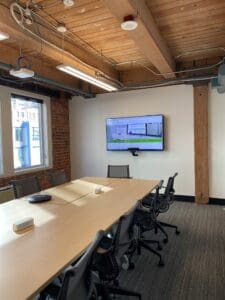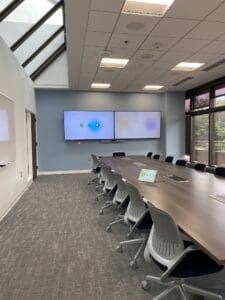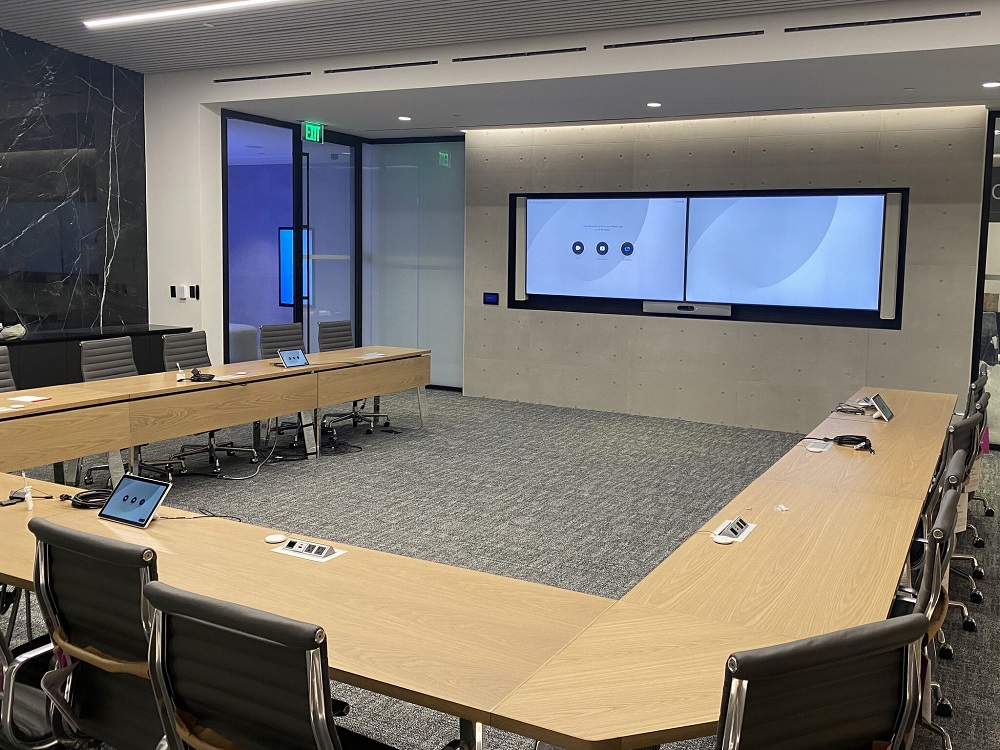For the last two years, remote workers have been gaining an intimate familiarity with services like Zoom, Microsoft Teams, Webex, GoToMeeting, Google Meet and a host of other virtual-meeting platforms that have helped workers connect and collaborate with coworkers and customers.
Despite spending hours upon hours in virtual meetings, end users are still having issues getting these platforms to work for a variety of reasons. Now that companies are outfitting their offices with more conferencing technology to accommodate a hybrid workforce, those issues likely won’t subside anytime soon.
According to Aaron McArdle, CEO of RoomReady, an expert in conference-room integration, several variables are at play. They include the number of remote workers, the influx of different devices and platforms, and an IT team — already stretched thin by the pandemic — that now must become expert in collaboration software and hardware.
“Before [the pandemic], the ability to remotely participate fully was not a necessity,” McArdle says. “It was a ‘nice-to-have’ if you were sick and were going to come into the meeting via some platform. It was OK if it was mediocre or bad because you were going to be in the next meeting and catch up.”
However, remote workers now demand meeting equity with in-room meeting participants. “That just shines a light on all the other peripherals, like monitors, cameras, speakers and much more,” McArdle says.
Related: Cisco’s Hybrid Work Index Highlights Remote Work Flexibility, Equity
Compounding this issue is the level of comfort remote workers may have with their existing systems, especially if they procured their own peripheral devices. Now, if IT wants to standardize remote workers on specific devices and tools, end users will have to learn unfamiliar technology all over again.
These continued issues with hybrid-work technologies were illuminated by several recent pieces of research. One such study, done by collaboration-platform provider Dialpad, found that more than 50% of respondents say audio issues are their biggest obstacle. Other issues center on difficulty “reading the room,” video quality and the inability to integrate with other tools.
Another such study, done by IT monitoring and management software company NETSCOUT, finds that UC&C technology issues are leading to a large uptick in support tickets. Indeed, 43% of organizations surveyed say over half of all helpdesk tickets now relate to UC&C issues.
The company found that 72% of enterprises currently support between three and nine UC&C tools. That figure is up 9% from 2020. The overwhelming majority (98%) say collaboration software is essential to their organization’s hybrid-work policies.
 According to the company, the most common issues center on device configuration, screen sharing and updates. About one-third say poor audio and video quality, delays and an inability to log into meeting services are also leading to helpdesk tickets.
According to the company, the most common issues center on device configuration, screen sharing and updates. About one-third say poor audio and video quality, delays and an inability to log into meeting services are also leading to helpdesk tickets.
When employees can’t effectively use these meeting technologies, productivity suffers. NETSCOUT’s survey suggests that these issues are plaguing IT departments, with 31% of respondents reporting that they are “extremely concerned” about their organization’s UC&C challenges.
The level of concern seems to elevate the larger the company is. Forty-three percent of organizations that report more than $10 billion in annual revenue are “extremely concerned.” By contrast, just 29% of organizations with less than $10 billion in revenue express the same alarm.
A Lack of Visibility
According to NETSCOUT, half of respondents say they receive a helpdesk ticket for UC&C systems at least once a day, with 24% saying they get more than one per day. Helpdesk tickets cost $15 on average to address, so these UC&C challenges can end up draining an IT budget.
“You can see why an executive becomes that much more concerned when they have money riding on it,” says Eileen Haggerty, area vice president of products and solutions marketing at NETSCOUT’s enterprise business. Now, IT professionals are reporting that they have lost control of their remote employees’ use of unified-communications-as-a-service (UCaaS) systems, according to Haggerty.
Related: Videoconferencing Platforms Are Leading To More Support Tickets
One of the main reasons for that loss of control, Haggerty and McArdle report, is the volume of different vendors and a lack of interoperability. This creates a complex environment in which the path each call takes varies based on the specific products used.
“Maybe it’s just one call today — maybe one call this week — but, if it’s systemic, they have to be able to follow that path and pinpoint the source,” Haggerty says.
With a lack of visibility into the range of devices and platforms organizations are currently using across an undefined physical work environment, IT teams won’t be able to troubleshoot and fix end users’ problems.
Historically, onsite workers have enjoyed more IT support than their remote counterparts have, but IT is now tasked with supporting a workforce that can switch from onsite to remote depending on the day of the week.
“IT people are not only overburdened but [also] just don’t have the tools and visibility that they have in the office,” says Scott Wharton, vice president and general manager of Logitech’s video-collaboration business.
Monitoring and Analytics Tools Can Help
Against that backdrop, the tech industry has released tools designed to help organizations get a grip on this hybrid-work collaboration mayhem. In addition to NETSCOUT releasing new UCaaS capabilities for its Smart Edge Monitoring solution, Logitech has announced updates to its Sync device-management platform that extend to personal-collaboration devices like webcams, headsets and docking stations.
 The tool already provides insights (e.g., meeting room occupancy) for onsite systems and meeting rooms, thus helping IT managers make data-driven decisions and rethink their office spaces. Now, it provides visibility into an organization’s entire hybrid-work environment.
The tool already provides insights (e.g., meeting room occupancy) for onsite systems and meeting rooms, thus helping IT managers make data-driven decisions and rethink their office spaces. Now, it provides visibility into an organization’s entire hybrid-work environment.
According to Wharton, the expanded Sync capabilities give IT visibility into their remote workers’ personal-conferencing devices, along with analytics from all those devices. “It’s going to become a critical function for IT personnel because, today, you call up and go, ‘My Teams is broken,’ and the IT person goes, ‘Yeah, I don’t know how to fix that,’” Wharton says.
Up until the last two years, IT tools have largely been designed to support employees in the office, but the pandemic and the hybrid-work transition have shattered that notion. Without the right tools, supporting the hybrid workforce is challenging. And, if those tools aren’t adopted, we should expect to see a negative impact on productivity.
“You can’t just walk over to your IT bar and get it fixed at home,” Wharton says. “I think we’re going to see a productivity crisis if we don’t [fix it].”
Keep UC&C Systems Simple
We’ve highlighted just two platforms that can help give IT visibility into their remote workers’ UC&C woes, but there are many more, McArdle says, adding that his firm routinely encourages customers to consider leveraging those solutions that exist within the UC&C platforms themselves, as well as those from other IT providers.
However, one of the keys to ensuring that UC&C solutions don’t break and lead to time-consuming IT helpdesk tickets is to build simple, easy-to-use solutions that don’t deviate from the vendor’s intended use.
“The most important thing right now is not to deviate from the way the manufacturer of the hardware and the platform intended for it to work,” McArdle says. “If you start to turn to custom things or add bolt-on features, you’re most likely going to get bit.”
The global movement to remote work led to the software-as-a-service (SaaS) movement exploding due to the easy procurement and deployment of cloud-based apps like videoconferencing. And it’s those software providers that are driving innovation in the industry.
“It’s more important now than ever to put the room in a way that it’s supposed to be put in,” McArdle concludes.










